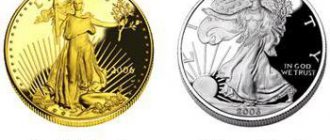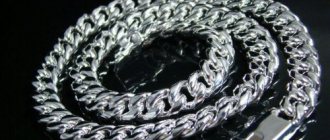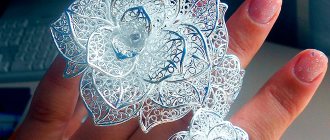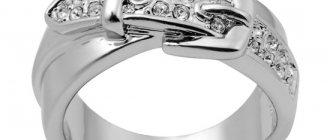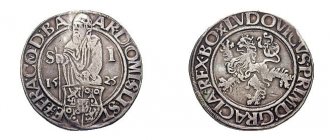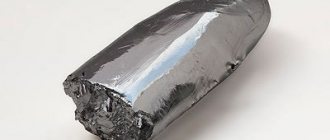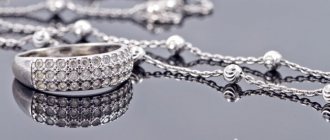“Where is the hallmark on silver products and how can I find out the hallmark of silver?”
Jewelry lovers know that you need to look for . After all, according to the rules of jewelry design, hallmarks (silver, Russia) should not spoil the appearance of the jewelry, change the texture, or affect the aesthetic properties.
When the jewelry is small or consists of weightless parts, even the best silver is located on a fused plate . In the store, we place two or three pictures of jewelry on product cards. Including an “internal angle” so that customers can see the sample. Zoom in on parts of the image! Find out which silver standard is better - further.
“What types of silver exist and what do the numbers mean?”
The information provided by the types of marks on silver is the proportion of pure precious metal to impurities. 999-grade silver, which is used in the production of bullion bars as a monetary unit and in dentistry, is equated to this status .
Pure silver is shiny white and soft. You can cut pure silver with a kitchen knife. To strengthen the alloy and reduce the cost of making jewelry, copper is used. Therefore, low-grade silver items (silver spoons and other utensils, figurines, dishes, inexpensive decorative pins) have a reddish tint.
800 , 830 and the popular 875 are low grades of silver. The hallmark of 875 silver is a good sign if you see household items, cutlery, and interior decorations. What kind of standard silverware still comes in - further.
800 sterling silver is used as a plating material for brass cutlery. What other samples of silver are there? In jewelry, no alloy below the hallmark of 800 silver is used. If you notice other numbers, this is a fake.
The situation of branding with base metals, but with their application
Often, such a precious metal as silver, like many others, is used not only as the main component of jewelry, but also as a coating. Of course, gold is more popular in this industry, however, silver is also used with considerable success.
Silver is usually used to cover kitchen utensils, that is, spoons, forks, etc. This technique was especially popular about thirty years ago.
In the USSR, it was considered correct to put several samples at the same time on such products, that is, a coating mark was placed and, accordingly, a sample of the main metal was placed next to it.
The marks looked like this:
Cupronickel could most often be designated “MN”. Occasionally, some cookware manufacturers indicated "MELCH".- Neuzilberg, or “New Silver”, had the name of the sample - “MNTs”.
- Aluminum accessories – “AL”.
- Products made of stainless steel were designated accordingly “STAINLESS”.
A similar system is still used today, although there are often some “very” old antiques that can directly be called antique value.
So, it was not customary for some such products to be branded with double hallmarks. That is, if a test was taken, it only exclusively reflected the essence of the applied coating.
You may be interested in: Jewelry stones: an overview of the most popular
These antiques in our time are often accompanied by incidental situations. Some antique dealers openly put them up for sale, passing them off as full-fledged silver items.
Today, it is mandatory to place a hallmark on silver alloys:
- Sample No. 800. In this alloy, it is customary to use 2 types of metal. 20% of such jewelry is copper, and the remaining 80 is silver. Such alloys have specific shades of yellow and are prone to rapid oxidation.
- Sterling No. 875. 875 Sterling Silver is the standard alloy for most kitchen utensils. It is also used in the jewelry industry.
- Sample No. 925. As mentioned, this alloy option has become the most popular. There are several objective reasons for this. Firstly, it is the preservation of the original shape due to the properties of the metal. Secondly, it completely lacks “yellowness”, since it does not contain copper. Thirdly, this alloy has the highest anti-corrosion properties. And finally, 925 standard refers to the best price-quality ratio. 95% of the alloy is used in the jewelry industry and only the remaining 5% in all other industries.
It should also be recalled that the scope of silver is much wider than it seems. For example, many artists use it successfully. For working with painting, 960 alloy is considered the most relevant.
“What is a hallmark and what are the hallmarks of silver (photo)?”
Hallmarks are an icon embossed on precious metal that certifies the composition, indicates the country of manufacture or sale, the type of metal and the inspection authority. In some cases, the jewelry bears the mark of the author, workshop or country of origin of the metal - the types of silver samples are varied and differ around the world.
On the territory of the Russian Federation, for certification they use a mark with a relief image of a female head in a kokoshnik , turned to the right, and recently in its place there was a hammer and sickle (Soviet marks in silver). The highest standard of silver and the lowest had this symbol.
Silver samples in Tsarist Russia also included a badge with a head in a kokoshnik - it appeared in the nineteenth century. Hallmarks on silver in Tsarist Russia were set using the spool system, the most popular among them being 84, 72 and 74. These are low and medium grades of the precious metal.
Silversmithing in the 18th century
Immediately after the founding of St. Petersburg, Peter I invited artisans from Europe to the new Russian capital, among whom were many gold and silversmiths. In 1714, the emperor allowed jewelers to create workshops, which were headed by a headman endowed with special powers.
In the first half of the 18th century, they first began to differentiate jewelers by profile and workshops appeared that specialized only in silver, although many also worked with gold. Russian craftsmen soon united into one workshop, which included:
- court jeweler Pazunov (Pazulov);
- Samson Larionov;
- Fedor Razumov;
- Mikhail Belsky;
- Ivan Libman.
In 1793, the Russian workshop consisted of 44 jewelers, each master was required to mark his product. Information about stamps from that period is very scarce. It is known that so-called “name tags” were applied to the products, which consisted of the manufacturer’s initials. Towards the end of the 18th century, in order to avoid confusion, masters began to indicate their full first and last names on their creations. It was not necessary to register such marks, so the markings of that time are diverse.
During this period, silver mining in Russia was already in full swing. In 1704, the Nerchinsk silver smelting plant began operating, and coins were minted in the capital. With the discovery of the Altai and then Pechora deposits, the issue of silver ore production was finally resolved. The development of the mining industry was also facilitated by the fact that until 1782, anyone was allowed to search for and smelt precious metals.
The transformations of the first Russian emperor led to changes in the lifestyle of the nobility. Following European customs, new household items appeared in everyday life: silver accessories, tableware, toiletries. Throughout the 18th century, styles changed - under Peter and Elizabeth, baroque came into fashion, during the “golden age” of Catherine II, rococo and classicism gained popularity. Products of this era are characterized by a mixture of trends - elements of different styles could be combined in the decoration of one item.
“Which type of silver is the best?”
A hallmark on international silver consists of four elements – “pictures”, letters, numbers and frames. The latter encircles the first three values; by the shape of the mark you determine what kind of metal is in front of you. A rectangle with two rounded edges means silver.
What is the highest standard of silver? Silver jewelry is made from high-grade silver. The more pure silver in the composition, the finer the details of the jewelry.
High standard silver - 916 (was popular in Europe), hallmarked silver 925 , 960 - does not oxidize, it has antiseptic properties. Popular in jewelry, “sterling silver” (925 silver hallmark), which became widespread three centuries ago in Great Britain. Rings, earrings, chains, and expensive dishes are made from it.
Old silver spoons have samples in the spool system. Silver tablespoons of 84 standard correspond to 875 standard. But the cost of a silver spoon of 84 standard is higher than that of a product made of low-grade silver of the same weight, since such a spoon is an antique.
What types of silverware are best? Opt for 925 in jewelry and 875 in accessories and tableware. Silver is different in color! The higher the standard, the whiter the metal.
How are silver items branded in the Russian Federation?
If we compare all the available alloys, it is obvious that they are all inferior to 875 and 925 samples. As for the brand itself, the most popular and widespread is the head of a woman in a kokoshnik, looking to the right.
The second common mark is an unusual image in the form of an ordinary oval, but with one addition in the form of the absence of sides.
If you look at the lower left corner, you can see a regular letter. This letter directly indicates the geographical component regarding the place where this product was born.
In addition, branding can be done in other ways with other designations, for example:
- The category of main hallmarks usually includes letters with the designations “A” and “B”, “C” and “D”. It is believed that if this designation is present on the product, nothing else is required. The first two abbreviations have already been described a little higher. As for the other two, they look exactly the same. The only difference is that on this brand you can see a five-pointed star with a hammer and sickle instead of the usual woman in a kokoshnik. All these letters were widely used during the Soviet era in the field of markings in the jewelry industry. In Russia, they refused to use them.
- All types of marking described are not final. There are others too. For example, such options as D E F and Z., although they are not considered independent in the definition, they still took place in use. From this group, only the letters “D” and “E” have survived to date. It is made as a rounded rectangle with a hole inside. As for the letter “E”, its purpose is to indicate the lack of authenticity of the metal in the declared sample.
By the way, regarding the letter “B” described above. Even now, some jewelry manufacturers, particularly those intended for sale abroad, indicate it on their jewelry.
The only difference: instead of a letter and the usual woman in a kokoshnik, a ship is engraved on the metal. If you look at the law, you can find out that this type of registration is more than enough.
You may be interested in: Precious metals around us: in what radio components can they be found?
“What should you do if you find accessories or silverware that have strange hallmarks?”
Antique silverware, the hallmark and mark on which indicate a workshop where the jewelry was made by hand, is not uncommon. The mark on the silver spoon is amazing! Until the 19th century, there was no unified system for marking and branding silver jewelry in the world, although stamps were placed on jewelry. Today, ancient jewelry originating from Great Britain , Germany and France . On the jewelry, in addition to the sign of the country of manufacture, a symbol of the country of origin of the metal was placed (in the case of France and Great Britain, the icons of the colonies).
Author's workshops - Parisian and Venetian - branded jewelry handmade by their jewelers. Therefore, it is normal to find a strange mark on family jewelry. If this happens to you, seek advice from a store expert. We will be happy to tell you about the samples and refer you to a jeweler who will help establish the origin of the accessory.
Sincerely, Andrey Fedorenko , director of the online store TopGrant.ru
Still have questions? Leave a request and we will contact you!
Order a consultation
We recommend that you familiarize yourself with the catalogs:
- Silver rings
- Silver earrings
- Silver chains
How did hallmarking of precious metals begin?
If we turn to historical facts, we can find out that from the beginning of the 18th century until the 20th century, the assay system was used to indicate the value of a particular product.
At that time, using any ring or brooch one could easily find out such facts as:

At what time was the jewelry made?- Who made it?
- Where the craftsmen worked on it.
Official branding originated in our country thanks to Peter the Great. It was he who first defined the “spool” assay system not only for gold, but also for silver. A total of 4 samples were identified.
Marking metal at that time was considered an extremely responsible undertaking, and by law, not everyone could apply the mark. Usually this ritual was available only to the master, who made this or that product. As a last resort, the headman could do this.
Some time later, at the beginning of the 19th century, the branding system began to gain momentum. In large cities, special assay offices began to appear more and more often. Dramatic changes also affected the print. The following appeared on the print:
- Precious metal sample.
- Initials of the person being verified.
- And the city coat of arms.
You may be interested in: Copper smelting at home: what to consider?
Since then, it has become possible to determine all the ins and outs regarding any piece of jewelry.


